Storage location
Consideration should be given to the differences between outdoor and indoor storage of firewood. For large volumes, the undisputed favorite is the arrangement of separate firewoods and sheds. It is necessary to take into account the fact that dry logs are used for high-quality heating, so in the house you should also think about where to put the batch for ignition.
Outdoor storage
You should start with a more familiar way. Since often for heating a house, if there is a bathhouse or a frequently used grill zone on the site, a large amount of combustion material is required, an outdoor location is mainly used. This includes the following placement methods:
- adjoining location,
- canopy,
- barn,
- open warehouse.
One of the most convenient options is the placement of fuel stocks near the house. In this case, close access to the logs opens, you can take them as needed in small batches. The wood along the walls provides additional thermal insulation.

An excellent solution is to equip a storage facility on the terrace of the house in the barbecue area
If it is impossible to achieve optimal conditions in this situation, it is better to follow the more familiar solution to the issue and equip a separate storage space. A fire box for firewood in the form of a canopy is a good option, the construction of such a structure does not take much time, effort and expense, and the safety conditions and other aspects will be met. A shed for storing fuel material provides better protection from precipitation, but at the same time, not everyone has the opportunity to build an additional utility structure on the site.
We recommend that you read the material on self-preparation of firewood in addition to this article.
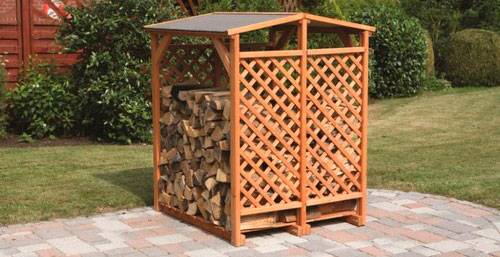
The covered wood storage area provides optimal conditions. Also, such a log can become an object of yard design.
In order to be able to transfer the required amount of material to the furnace zone without much effort, it is necessary to consider the presence of special devices. Some people still use buckets and wheelbarrows, but a firewood carrier is the best option. You can make it with your own hands from thick fabric. A more economical option is two cords that grab the logs, but they are much less convenient and less convenient to use.
You can also take into account the baskets
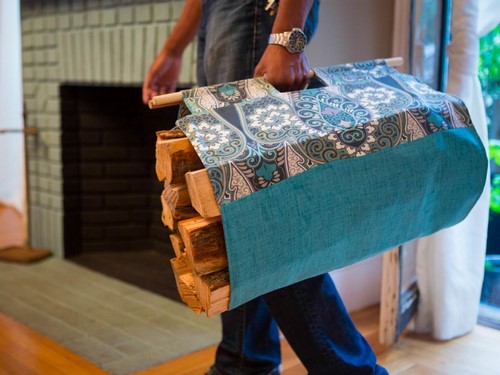
A rag carrying is the best option for delivering firewood from an outdoor storage place to the firebox
To sew a rag carrier, you will need a piece of fabric and two wooden beams. To begin with, a rectangular fragment is cut out, the edges of which are processed in a zigzag with a hem. Belt loops are attached along the narrow sides - two on each edge. Stripped crossbars are inserted into them. The result is a kind of bag, where it is convenient to put firewood for carrying.
Where to place firewood
The best option for storing firewood in the country or in a country house will be a shed that can be locked with a key or with a padlock. In domestic realities, when theft on plots is flourishing, you should not be too naive and leave your strategic stock of wood under an ordinary canopy or in a pile near the house. In addition, good firewood is not cheap, and therefore is a valuable prey for scammers.
If the territory of your house is reliably protected or the site is located in the wilderness, it will be even easier to find a place to store firewood on the street:
An excellent solution for storing timber can be a banal shed, which is many times easier to build than the simplest shed. The canopy can be without walls, with a roof on pillars. This design fully provides protection from precipitation and ventilation of the tree. You can build a shed for storing firewood with one or three walls, so we can always have access from the street, which means it is easy to fold and collect logs if necessary. The canopy can be attached to outbuildings, to the house, or made as a separate structure.
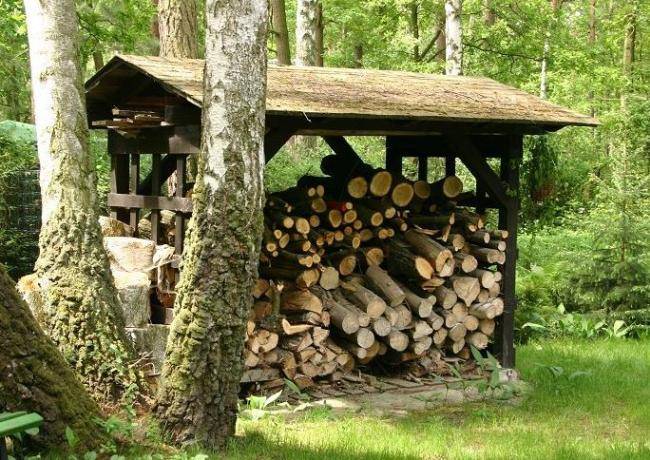
Small canopy built on the plot
- The original option for placing firewood between trees. A woodpile of this type is convenient, first of all, by the possibility of quick and easy storage of wood. The trees will act as supports, securely holding the logs, and we will only have to cover the top of the stack of firewood with foil, protecting them from precipitation. If you decide to create such a storage system, then choose nearby trees, as otherwise there is a chance that the woodpile will fall flat.
- You can place firewood along one of the walls of the house. Such storage can even be considered as an external decoration of the building, since it looks quite interesting. The downside can be considered the lack of airing the facade of the house, which in some cases can become a negative factor and a prerequisite for the appearance of mold on the house. When laying out a wall of wood under the roof of the house, leave a small gap for air to enter.
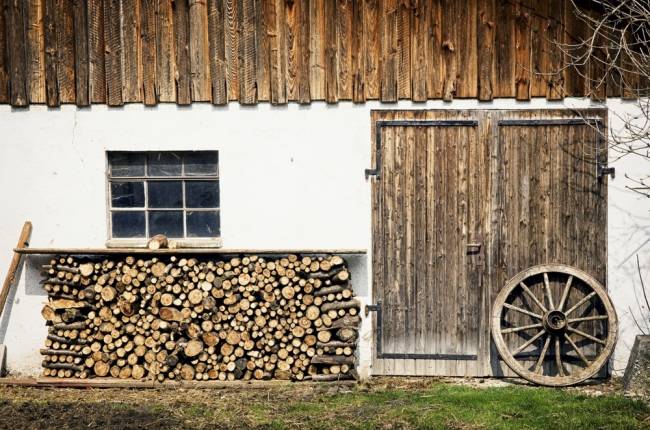
Storing firewood near the wall of the house
Firewood is stored under the stairs. This method allows you to competently use not the best place, as well as successfully place the forest with appropriate storage conditions. The ladder reliably protects the firewood from precipitation, and we do not need to go far into the barn for them. Very convenient, especially in winter time.
You can install a woodpile in any convenient place on the site right in the open air. For example, along a fence near a bathhouse or next to a garden path, in places where logs can be easily collected for use. Usually, such storage assumes that there is a large amount of firewood, a shed for which a large size is needed
With this arrangement of the woodpile, special attention should be paid to the stability of the structure, as well as to the base of the object.
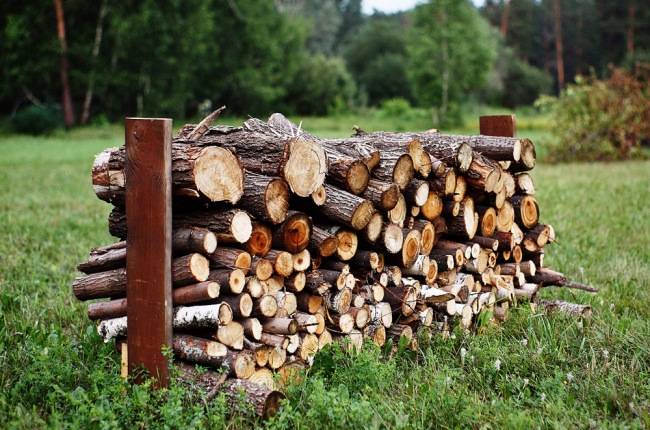
The easiest woodpile option
For creative people, a freestanding woodpile, made as a decorative structure, will be an interesting solution. With an unusual layout, such an art object will become not only a timber warehouse, but also an unusual decoration of the site. When creating such a structure, it is worth remembering the main purpose of firewood, which means to consider the practicality of your design so that it does not fall apart after removing a certain number of logs from it.
Note that a place should be allocated for a couple of stacks of firewood in the place of their direct use. For example, storing firewood in a sauna will allow you to quickly melt the stove, and a small storage of logs near the barbecue will allow you to focus on cooking.
In order to place a couple of armfuls of firewood in a house by the fireplace or stove in a country mansion, you can use special decorative accessories. Most often, they are forged of metal, and their appearance can be absolutely anything: classic or modern.
Large fireplaces and stoves may have special places for loading logs, in which they are dried and prepared for use. You can use a portable woodpile made of twigs.
As you can see, there are many options for placing a woodshed on the site, and even if you put the firewood down for the first time inconveniently, then next year you can change the place of their storage. Choose a suitable place according to a whole list of criteria, let the firewood be safe and sound, dry and ready to use, let it be easy to fold and take, and how your woodpile will look like, you will already decide in the process.
Determination of the volume of firewood
Many summer residents and owners of private houses are interested in the question: how to calculate the volume of firewood when buying, so as not to overpay and stock up on them in abundance?
To determine the volume of chopped firewood, there are special coefficients and units of measurement.
The volume of the body and the volume of firewood are different things
- The warehouse meter is a densely packed woodpile, the width, height and depth of which is one meter.
- A cubic meter of firewood is calculated with a factor of 0.7. That is, one warehouse meter is equal to 0.7 cubic meters.
But firewood is usually brought in bulk in a car. In order not to waste time storing firewood in a woodpile and determining their cubic capacity, the volume of the car body is multiplied by a factor of 0.82 and the number of storage meters is obtained.
Knowing the calculation methodology, you can always determine exactly how much firewood you need to pay for.
Well, the rest of the information you received from this article will help you choose high-quality firewood and keep them in their best condition until the moment they are in the firebox to give you the heat and beauty of a living fire.
Do-it-yourself woodpile erection
At the heart of the simplest firebox is a shelf for firewood and a canopy that protects them from precipitation. For construction, materials at hand are used: boards, timber, steel corner. It is better not to make the shelf solid so that the logs are well ventilated from below. In some cases, you can limit yourself to a couple of longitudinal poles. Maintain a distance that is sufficient to fix the logs. The fastening must be reliable and withstand the weight of the logs. To make the structure more durable, the pillars are buried 70 centimeters into the soil.
The canopy, under which firewood will be stored in the country, is better made gable. Even slate will do. In the case of a lean-to design, a slope is made forward when the building is adjacent to the house. The detached building has a backward slope of the canopy. The edges of the roof should go beyond the boundaries so that the flowing water does not fall on the tree. Such preservation conditions will become the guarantor of the high quality of wood fuel, even in prolonged bad weather. There are two main conditions: excellent air circulation between the logs and a well-built canopy.
 Do-it-yourself firewood shed
Do-it-yourself firewood shed
So what is firewood?
If you think about what firewood is, and look in the "free encyclopedia", it turns out that firewood is simply pieces of wood intended to be burned in the furnace of a stove or fireplace, to get heat and light, but how else, after all, when burning, heat and light are released at the same time. To do this, they need to be prepared. The next question arises: how to harvest firewood?
The stove must not be heated with damp wood! When the stove is fired with damp wood, the stove is poorly heated and smokes. When burning with raw wood, most of the energy is spent on drying the fuel itself, and what remains will go to heating the walls of the furnace. It is difficult to warm up the stove with raw wood. An open fireplace will most likely not work at all.
The smoke will not go into the chimney. Also, heat-resistant mixtures, adhesives and pastes often do not withstand the effects of moisture and deteriorate in a very short time. This leads to early destruction of the furnace, and repairing the furnace is difficult and expensive. Also, when burning with raw wood, you will spend several times more money, and you will receive less heat.
Recommendations for storing and drying firewood
The lower the moisture content of the wood, the higher its heat transfer. This can be seen from the example of the calorific value of oak firewood: freshly sawn oak with a moisture content of 60% emits 2.25 times less heat than with a moisture content of 20%.
| Humidity, % | Calorific value, Kcal / m3 |
| 10 | 3321 |
| 20 | 2916 |
| 30 | 2511 |
| 40 | 2106 |
| 50 | 1701 |
| 60 | 1296 |
| 70 | 891 |
1. Time of harvesting / laying firewood in a woodpile
The minimum drying time depends on the month in which the wood is placed in the woodpile.
| January | February | March | April | May | June |
| 220 | 190 | 140 | 120 | 100 | 80 |
| July | August | September | October | November | December |
| 310 | 300 | 280 | 270 | 250 | 240 |
When stacking firewood in a woodpile in April, it will dry out in 120 days and will be ready for the upcoming heating season.And the firewood harvested in July will dry up in 310 days and will be ready only for next winter.
If you buy firewood and do not check their moisture with a moisture meter, then treat them as freshly sawn: buy in advance and allow time to dry.
2. Dry firewood in bulk
Leave it in bulk in an open area for several weeks before stacking it in the woodpile. Due to the large distance between the logs and the constant air circulation, the wood will dry out faster.

3. Storage location
It is generally accepted that the best place to store firewood is a garage, shed or other enclosed space. This is true if the room is regularly ventilated.
Ventilation is critical for good wood drying. Otherwise, the wood will get damp and rot
It is optimal to store firewood in a woodpile with a canopy to protect it from snow and rain. Typically, a woodpile is built along the wall of a house or fence, which serves as a back wall and provides structural strength. The front wall must be left open so that air can freely flow to the wood and circulate between the logs.
4. Don't put wood on the floor
First, it will make it harder for air to circulate. Secondly, the wood will saturate the moisture from the floor. Stack firewood on a special foundation made of crossbeams, pallets, or bricks. This will ensure good air movement from the bottom up and protect the wood from dampness.
5. Stack the wood perpendicularly
If possible, put each next row of firewood perpendicular to the previous one. So the wood will take up more space in the volume, but you will improve air circulation between the logs and speed up their drying without reducing the strength of the structure.
6. Chop wood along
The wood dries unevenly, which can be seen from my experiment with a moisture meter and several samples of wood.
Example 1: apricot branch, shelf life 8 months
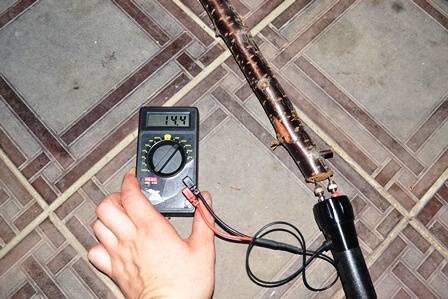
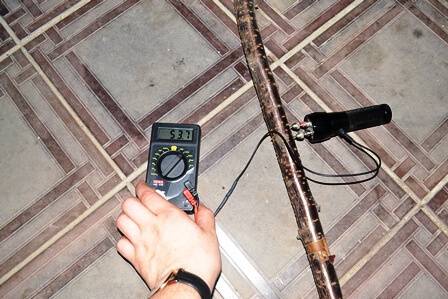
Moisture at the ends is 14.4%. The wood is not freshly sawn, it has dried well and is ready for use. But the moisture content of the same branch near the bark is 53.7%. Despite the fact that the drying period for this small branch is 8 months.
Example 2: freshly sawn wood
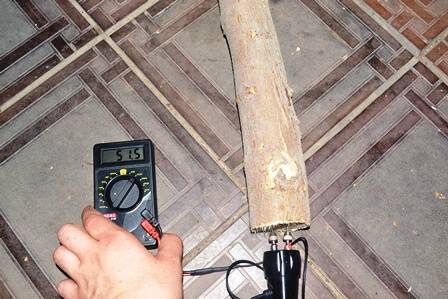
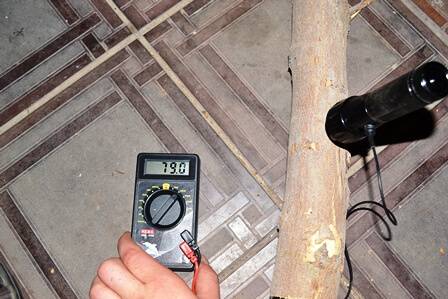
Humidity at the ends is 51.5%, which corresponds to freshly sawn wood. The moisture content of the bark is 79%. Conclusion: the bark "envelops" the wood material and prevents moisture from evaporating. If you are using round firewood, cut it lengthwise into two or four pieces so that the sides are barked and dry well. published
P.S. And remember, just by changing your consumption - together we are changing the world! econet
Fundamental rules
Based on the experience of many summer residents and rural residents, it is possible to formulate a number of simple rules that allow you to competently organize the storage of wooden firewood. All of them are intuitive and simple, so it will be extremely easy to remember and use them:
- The stack of firewood must be hidden from external influences of nature. If you do not have a full-fledged wood-breeder at your disposal, then at least cover the folded woodpile of firewood on the street with moisture-proof materials, this will protect the tree from snow and rain, and will not let it get very wet. As a shelter, you can use cellophane film, old roofing material, corrugated board, metal sheets from the fence, siding, everything that remains from construction work. Place a stack of firewood near the stove so as not to melt it with damp wood, but to have a dry supply.
- The woodshed must be ventilated. When building a full-fledged woodshed, this fact should be taken into account, which means that the air can easily circulate in the shed for storing firewood, and the harvested wood should be dried. With this approach, the wood will dry well, will not mold, rot. Otherwise, there is a possibility of dampening even dry wood.If you are going to cover the assembled stack with film, then cover it on top, you do not need to do this on all sides.
- Keep firewood away from fire. Obviously, it is not worth storing firewood next to a brazier or campfire site. A slight carelessness will deprive you of all the wood reserves, and can also bring serious problems with the entire economy. Nevertheless, you can always allocate a small place next to the stove, fireplace, barbecue, where the stack of firewood can dry properly for future use.

The easiest way to stack firewood
- A well-organized woodpile needs a solid foundation. When starting to collect a woodpile of firewood, make sure to create a solid foundation from below, a kind of foundation. Laying firewood directly on the ground or on the floor in a barn is not recommended, as the earth exudes moisture, which means the wood can become damp. An improvised foundation for a woodpile will become a strong foundation that does not allow the pile to fall apart, protection from moisture from the ground, and also helps to ventilate the stored tree. To create the base, you can use any available materials: bricks, boards, large logs, plywood, everything on which you can neatly stack the stock of wood.
- When folding the woodpile, you should take care of its stability. Regardless of where you are going to put the firewood, it should be done securely and firmly so that the woodpile does not fall apart. Do not once again think about how to fold firewood beautifully, it is better to do it neatly, steadily and in the right place.
- The stack of firewood should be convenient for use and the next storage. When choosing a place to build a woodshed or place a woodpile, you should take into account the possibility of loading them with firewood, as well as the principles of subsequent use. Harvesting firewood is not the easiest and fastest process that requires a lot of time and effort. Is it worth increasing its duration due to the far-located place of storage of the tree. Additional features of your shed should also be taken into account, for example, the layout of firewood by type on shelves or in different corners. In the future, it will be easier to find the right tree for your needs.

Multipurpose outbuilding
Note that by competently organizing the storage of firewood in the country, you can easily use your stocks, and, if necessary, replenish them. A neatly folded, sturdy log shed will keep your entire tree dry; all you have to do is decide where to place it.
Firewood storage rules
The rules for storing firewood in a personal plot were born in the course of logical inferences. There is nothing secret about them, and you would certainly isolate them from your own stream of thoughts if you were puzzled by this question. But why reinvent the wheel when you can just hop on it and hit the road.
Rule # 1: absolute dryness
After all, you see, to heat the stove or fry a kebab on wet wood is a very dubious pleasure. In order not to sip it with a strainer, it is necessary, first of all, to provide the woodpile with 100% dryness. The easiest way to do this is to build a primitive shelter from any improvised materials available at the summer cottage that do not get wet:
- polyethylene film;
- roofing material;
- slate sheets.
Rule # 2: good ventilation
Blocked firewood on all sides is also not very good
It is important that the weather shelter is formed from above. The woodpile can be left uncovered on the sides
This will allow air to freely enter the stacked pieces of wood, one-on-one, and provide the necessary oxygen supply for long-term storage in a dry state.
Rule # 3: keep away from fire
Keeping away from fire is also quite obvious. But according to statistics, most country house owners prefer to store wood in close proximity to a barbecue or grill. In fact, this is a rather strange decision, because for completely dry firewood, just one spark is enough to ignite. The result will be very deplorable: at best, only the tree will be destroyed, and at worst - and the barbecue, including, along with all the property adjacent to it.

Rule # 4: Solid Woodpile Base
Only a beginner unknowingly can form a woodpile right on the open ground or on the floor in a pantry or basement. Such storage of firewood is highly undesirable. The reason is simple: the bottom layer, which is actually on the ground, will get damp, transferring moisture higher and higher. In order to prevent this from happening, a simple but strong base must be built for the woodpile, which will raise it above the ground line. You can take logs, bricks and boards as material for creating the base. This “foundation” has several undeniable advantages:
- provides ventilation to the bottom layer;
- guarantees high-quality and long-term storage;
- allows the wood to dry out under the influence of fresh air;
- prevents the spread of the fungus.
Rule # 5: Storage Resilience
Firewood can always be piled up and kept in a messy condition. But firstly, this entails certain consequences - from excessive dampness of the logs to mold. And secondly, this storage method takes up too much space. In this regard, a neat woodpile is not a luxury, but a “means of transportation”. I mean, a necessity. The firewood storage must be firmly on its feet. Otherwise, on the third day, your wooden "tower" will be flooded with stray cats, who will certainly come to look at the structure and will certainly test its strength.
Rule # 6: comfort comes first
Firewood doesn't just have to lie well - it has to be comfortable. Comfortable, first of all, for you. Because inanimate logs do not care what their location is. But it should be convenient for you to fold them and take them out when needed.
In this regard, when choosing a storage for firewood, pay attention to the options with cells that allow you to divide the wood blanks in portions and not destroy the entire woodpile, if necessary, pull out only a couple of logs

What to choose: secure storage (outsourcing) or warehouse rent?
You can rent a warehouse and organize storage yourself or contact a logistics company. You pay for the services, and the company you hire stores, accepts, processes, ships and moves the goods without your participation - this is called safekeeping. From the point of view of law, custody is regulated by Article 47 of the Civil Code of the Russian Federation. It describes the content of the storage agreement and the features of storage in a warehouse.
Advantages and disadvantages of using an outsourced warehouse (safe storage)
Advantages:
- The lessee pays only for unloading, storage and packaging of the goods.
- If the goods are spoiled, the logistician pays a penalty to the client. In case of fire or theft, the logistics company will compensate for the losses.
- The warehouse operator pays the costs of maintaining personnel and equipment, keeps records of goods, unloads and delivers. The tenant is relieved of these worries. Maintenance of workers and equipment is included in the rent.
- You focus on business development and do not waste time on recruiting personnel, accounting for goods, organizing unloading and delivery.
Disadvantages:
Warehouse rent: pros and cons, differences from safekeeping
Advantages:
- You yourself choose the desired warehouse in a convenient area for you.
- It is convenient to sort the goods.
- You choose at what time to unload and deliver the goods.
- You can store any kind of goods.
- You can use the warehouse on the day of the lease agreement.
Disadvantages:
- The lessee is responsible for the risks and damage to the goods in the rented warehouse.
- When renting a warehouse for storing goods requiring special storage conditions (food, animals, explosive and poisonous substances, medicines), you will need a lot of additional documents. For example, in order to open a pharmacy warehouse, in addition to the permission of Rospotrebnadzor for its placement, you will need a whole package of documents.
- You pay for the entire rented area, even if the goods are stored only on a part of it.
- All expenses for equipment, payment for the work of personnel are borne by the tenant.
- You yourself are engaged in the preparation of logistics documentation and select the optimal number of employees to perform work in the warehouse.
- It is necessary to allocate additional time to resolve issues related to delivery, distribution of goods, and additional processing.
How much firewood do you need for the winter
Procurement work begins by determining the required amount of material. At first glance, this is simple, but there are several very important factors to consider.
What to consider when calculating
- Humidity of raw materials. It significantly affects heat transfer. Raw material burns poorly, gives less heat. The freshly chopped poles are stored in a protected from moisture, well-ventilated place. They need to lie there for a year so that the excess moisture is gone. Only then will they become a good fuel.
- Wood grade. The highest heat transfer coefficient is found in dense solid rocks. These are beech, oak, birch. They burn longer. Less dense species, such as pine or aspen, burn faster. They are good for kindling. You can choose a combination of different rocks to get good heat transfer and less soot clogging the chimney.
- The volume of the rooms. An accurate calculation of the area will not work, because the height of the room is very important. The higher it is, the more fuel will be needed. On average, a height of 2.8 m is taken for calculations.
- The efficiency of the heating device. So, for a furnace and a boiler, it will be different. The most efficient pyrolysis boiler, the least effect is given by the stoves. Heat loss is also taken into account. It is best for the building to be insulated in accordance with building standards.
- The duration of the heating period. For the southern regions it is 3-4 months, for the northern ones 6-7. Since people have not yet learned how to order the weather, it is worth taking into account the long spring and cold autumn. Better to have a small supply than not enough fuel.
In order not to carry out complex mathematical calculations, the easiest way is to find out how many cubes on average are used to heat a house. It's good if this can be done on past winters or ask the former owners.
General rules for storing crops
For the best preservation of most garden crops, the following rules must be followed:
- All vegetables and fruits that are designed for long-term storage must be absolutely healthy and without any mechanical damage. Otherwise, the risk of the disease is very high. And every sick fruit will almost 100% cause damage to all neighbors. The entire crop must be dried before storing it in storage.
- Do not leave vegetables and fruits of an early ripening period for long-term storage. They can be stored for a maximum of 4 months, even if you create ideal conditions for them. Only medium-late and late varieties are suitable for long-term maintenance.
- The room where the food is stored must be dry and well ventilated. If you find condensation on the surface of the fruit, then the ventilation is not all right - it needs to be adjusted.
- The room temperature should not fall below 0 ° C and rise above 15 ° C. At lower rates, most vegetables will start to rot, at higher rates, they will dry out or sprout.For the bulk of crops, the optimum temperature is 2-4 ° C.
- When storing fruits and vegetables, such characteristics as moisture are very important. For most of the crops, the best moisture content is 90-95%. Fruits with a dense dry skin require no more than 75-80%.
- The storage should be protected from sunlight. In some vegetables, such as potatoes, exposure to light produces an organic poison called solanine, which is unhealthy.
- In a place where vegetables and fruits are kept, there should be no insects, rodents and any other living creatures that can cause mechanical damage to your crop and become a carrier of infections.
- Fruits of different types must be stored in separate containers. They should never come into contact with each other. The only exception is potatoes with beets. Their neighborhood benefits both crops: beets protect potatoes from rotting, taking away excess moisture, and beets protect potatoes from drying out.
- Boxes and other storage containers must not be airtight. It is necessary that the air circulates freely between the fruits, so always choose containers with holes.
- From time to time, it is necessary to revise the crop. Any fruit showing signs of damage should be discarded immediately. You should also remove those vegetables that were in the immediate vicinity of the spoiled fruit.
Even a grown crop requires our care.
